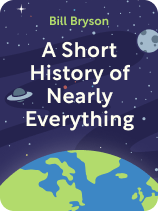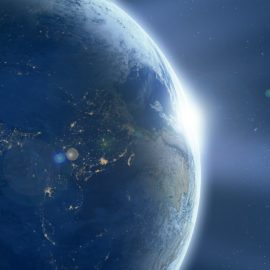

This article is an excerpt from the Shortform book guide to "A Short History of Nearly Everything" by Bill Bryson. Shortform has the world's best summaries and analyses of books you should be reading.
Like this article? Sign up for a free trial here.
When and how did our solar system form? Why is the universe fine-tuned for life? What do scientists know about the origin of life?
Scientists have learned a ton about the universe and the Earth. A Short History of Nearly Everything by Bill Bryson covers the major discoveries and theories and points out what we still don’t know.
Keep reading for an overview of this accessible guide to science and natural history, from the big bang to the arrival of hominids on Earth.
Overview of A Short History of Nearly Everything by Bill Bryson
A Short History of Nearly Everything by Bill Bryson is a result of the research that Bryson conducted to remedy his ignorance about science. One day, while traveling and watching the world go by through an airplane window, he realized that he knew very little about the natural world. As a child, he had found science books confusing and inaccessible.
If Bryson’s exposition of the natural sciences can be distilled down to a single thesis, it’s that science is not cut-and-dry: Although science has made many important discoveries, there are still things that scientists don’t know or can’t agree on.
Bryson develops this theme both by highlighting a number of the unsolved mysteries that exist in the sciences and by exploring the human side of science and scientists. He relates many anecdotes about famous scientists, as well as not-so-famous scientists, who made important discoveries, only to have the credit for their work go to someone else. Scientists throughout history had their vices, foibles, insecurities, relational struggles, and personal biases, just like the rest of humankind. More than a few had bitter rivalries with one another. Because of these human factors, science did not progress smoothly but rather advanced by fits and starts.
We generally omit Bryson’s anecdotes about the human side of science, but we cover the highlights of both what scientists have discovered and what they still don’t know. Since Bryson presents his exposition as a history, we organize this material chronologically around three main topics: First, we discuss the origins of the universe and the solar system. Then, we discuss the geologic history of the Earth. And, finally, we discuss the history of life on Earth from its origins up to the present day.
The History of the Universe
Let’s begin our discussion of A Short History of Nearly Everything at the beginning of everything—the matter, energy, stars, and planets that make up our universe.
The Big Bang
According to Bryson, scientists don’t know exactly how or when the universe began. The most common estimate is 13.7 billion years ago. What they do generally agree on is that the universe started out very small and dense and expanded rapidly from this point of origin. This is known as the Big Bang Theory.
Bryson explains that the big bang was the beginning of space, time, and the elementary particles that make up matter and energy. Space itself expands outward from the point of origin.
The Life Cycle of Stars
At first, the universe consisted only of clouds of gas. Over time, gravity caused them to clump together. As they did, some of the densest regions collapsed in on themselves, creating stars. The resulting clumps of stars became galaxies.
As Bryson explains, stars ‘burn’ by fusing the atomic nuclei of lighter elements into heavier elements. Certain types of stars explode after they burn up all of their hydrogen and helium. The explosion is called a supernova.
The Formation of the Solar System
Bryson says our own solar system formed about 4.6 billion years ago in a nebula that had been enriched by supernova debris. Then, it took about 100 million years for Earth and the other planets to coalesce from this cloud of gas and dust around the newly formed sun.
About that time (4.5 billion years ago), the Earth collided with an object roughly the size of Mars. The impact ejected a large amount of rock and debris into orbit, forming Earth’s Moon. This was important for us because the Moon acts as a stabilizer for Earth’s rotation.
According to Bryson, Earth continued to receive a heavy bombardment of smaller asteroids and comets for the next 500 million years. These impacts provided additional water and carbon, which would later be important for life.
Unsolved Mysteries of the Universe
Bryson brings up several questions that scientists have yet to answer conclusively.
Why Is the Universe Fine-Tuned for Life?
Many parameters of the universe seem to have been optimized to just the right values that would support human life. Yet, scientists have not identified any physical principle or mechanism that would constrain all these parameters to have just the right values to eventually support life on Earth.
Bryson himself conjectures that maybe the answer is that life evolved to match the conditions that existed. So the universe isn’t fine-tuned for us—we’ve been fine-tuned for it by millions of years of natural selection.
Where Is the Rest of the Mass in the Universe?
When scientists use general relativity to calculate the mass of the universe, the number they get is 10 to 100 times greater than the total estimated mass of all the stars, galaxies, and other objects that they can detect in the universe.
According to Bryson, no one knows for sure how to account for this discrepancy, although most scientists favor one of two possible explanations. One explanation holds that missing mass consists of objects that just don’t emit or reflect enough light for astronomers to detect.
The other explanation is that there’s a type of matter that interacts only through gravity, making it fundamentally impossible to detect except by observing its gravitational influence on visible matter.
Why Is the Expansion of the Universe Accelerating?
Theoretically, gravity should cause the expansion rate of the universe to slow down over time. But recent measurements indicate that its rate of expansion is actually increasing. Bryson says there’s no consensus on what’s physically causing the expansion rate to increase.
The History of Planet Earth
Let’s consider Bryson’s exposition of Earth’s geologic history, its structure, and some of the natural forces that have shaped Earth’s surface.
The Age of the Earth
Bryson explains that scientists didn’t know how old the Earth was until the mid-1900s when lead-uranium radiometric dating was developed. To determine the age of the Earth, scientists resorted to dating meteorites, operating under the assumption that all the objects in our solar system formed at about the same time.
Interior Structure of the Earth
We know relatively little about Earth’s interior because we can’t directly observe it—even the deepest mines and boreholes barely scratch the surface. One source of information is the data recorded by seismographs, which record vibrations from Earthquakes. By comparing readings from seismographs in different locations, scientists can identify regions of different densities within the Earth.
According to Bryson, scientists have deduced by this method that Earth has four distinct layers: The outer crust, the mantle, the outer core, and the inner core.
Plate Tectonics
Scientists can also observe continental drift: the motion of different land masses and portions of the sea floor relative to each other. These observations imply that Earth’s land masses are riding on “plates” of solid rock that slide around on top of Earth’s molten interior.
Plate tectonics is not an exact science. Bryson describes how scientists can infer the past locations of continents by matching fossils or other rocks. But, the map looks different depending on which fossils they use.
Ice Ages
Bryson explains how ice plays a role in shaping the planet’s surface. Scientists infer that almost all of the Earth’s surface has been covered by ice at some point. There’s no consensus about exactly what causes ice ages to begin or end. Slight variations in Earth’s orbit or the tilt of its axis may be a factor. Volcanic eruptions could also play a role. The rise and fall of global temperatures also factor in.
The History of Life on Earth
Now we’ll turn our attention to what biologists can infer about the history of life on Earth.
The Origin of Life
According to Bryson, the origin of life is still one of the great mysteries of science. Scientists thought they were close to solving it in the 1950s when Stanley Miller succeeded in synthesizing amino acids. However, more recent discoveries indicate that the chemicals Miller used were probably not present in the atmosphere of the early Earth. And, after the amino acids were produced, it’s a bit of a mystery how they were first assembled into proteins.
Thus, scientists infer that the first lifeforms or pre-lifeforms must have been made up of simpler proteins and become more complex over time. But, so far, they haven’t figured out what these early proteins were, let alone how to recreate the process in the laboratory.
Darwin’s Theory of Evolution
Bryson asserts that one thing scientists do know is that all modern lifeforms share a common ancestor. This is because they all use the same genetic “language” and contain the same highly-specific proteins.
Charles Darwin presented a more academically rigorous case for evolution than some of his predecessors, and he was really the first to accept credit for the controversial idea even though it didn’t start with him.
Bryson explains that some of the original objections against Darwin’s theory of evolution have since been put to rest by new discoveries. Other controversies continue to this day, such as William Paley’s “watchmaker” argument. Paley contended that the intricate mechanisms of living organisms imply that they were created by an intelligent being, just as the existence of a mechanical pocket watch implied the existence of a watchmaker.
The Progression of Life
As Bryson explains, scientists have been able to piece together a history of the successive types of life forms that have prevailed on earth from the earliest bacteria to modern man.
Precambrian Life
Scientists can infer the history of early life forms from geologic information about the early Earth. Anaerobic bacteria must have been the first prevalent lifeform on Earth because Earth’s early atmosphere didn’t contain much oxygen. Once oxygen became abundant in the atmosphere, mitochondria started producing energy for cells by oxidizing nutrients. This facilitated the growth of more complex cells called eukaryotes, which eventually formed multicellular organisms.
The Cambrian Explosion
In the fossil record, a large number and diversity of multicellular organisms appear relatively abruptly about 540 million years ago.
There are two competing schools of thought regarding the Cambrian explosion. One holds that the Cambrian explosion does indeed represent a relatively sudden appearance of many new species. The other holds that these species appeared gradually, beginning long before the Cambrian explosion, and either didn’t leave earlier fossils or left fossils that scientists haven’t found yet.
Terrestrial Life
According to Bryson, the first lifeforms to emerge on land probably did so because of pressure from fierce competition for resources in the shallow water of the continental shelf. He says that this migration started with plants, followed by animals such as millipedes and crustaceans, and then followed by vertebrates that would become amphibians and reptiles. Birds and mammals appeared later.
Hominids
According to Bryson, evolutionary scientists generally agree that humans and apes descended from a common ancestor that lived about seven million years ago. Bryson says scientists think the transition from ape-like to human-like characteristics started with Homo Erectus about two million years ago. Most of what is believed to be true about Homo Erectus is inferred from finds at a single dig site in Kenya, leading some scientists to question its validity.
Australopithecines, another branch of the evolutionary tree, lived around the same time (two million years ago). Once thought to be part of humans’ ancestral tree, they are now regarded as an evolutionary dead-end.
The first Homo Sapiens, or modern humans, are thought to have lived around 100,000 years ago, but there are differences of opinion about their lineage. Some believe that both Homo Erectus and Homo Sapiens originated in Africa and then spread around the world. Others think that Homo Erectus evolved into Homo Sapiens synchronously all over the world. Neither hypothesis fits all the available data.
Extinctions
Bryson reports that scientists believe there were several times in Earth’s history when the majority of species on the planet died out. Bryson says scientists aren’t sure what caused these extinction events (or other, smaller ones), but they speculate that volcanic eruptions, meteor impacts, disease, solar flares, and other factors that could trigger global climate change could all be factors.
Human-Caused Extinctions
Bryson also points out that humans seem to have a talent for making other species go extinct. In recorded history, humans have hunted many creatures to extinction. In most cases, he says there was no apparent reason for humans to kill them.
Exercise: Uncover Disagreement on a Recent Scientific Discovery
In this exercise, you’ll pick a recent scientific discovery and examine the different perspectives on and explanations for it.
- Think of a recent scientific discovery that you’ve read about in the news, or peruse a science website or journal to learn about a new scientific event or discovery. Briefly describe it here.
- Either within the article or in outside sources, pinpoint at least two differing explanations for or perspectives on the discovery. Note how these explanations differ most from each other.
- Now, briefly note which explanation you find more compelling and why.

———End of Preview———
Like what you just read? Read the rest of the world's best book summary and analysis of Bill Bryson's "A Short History of Nearly Everything" at Shortform.
Here's what you'll find in our full A Short History of Nearly Everything summary:
- An accessible overview of the natural sciences
- A full history of the universe, Earth, and life as we know it
- A look at the unknowns and controversies that still exist in the sciences






